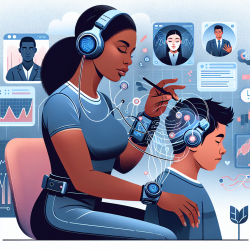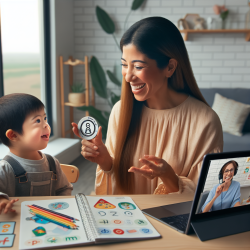Introduction
In the realm of speech-language pathology, the pursuit of enhancing cognitive performance in children is a critical objective. Recent research, such as the study titled "Regulation of brain cognitive states through auditory, gustatory, and olfactory stimulation with wearable monitoring," offers promising insights into how multisensory stimulation can be leveraged to achieve this goal. This blog explores the findings of this study and discusses how practitioners can integrate these insights into their therapeutic approaches to improve outcomes for children.
Understanding the Research
The study conducted by Azgomi et al. (2023) investigates the effects of auditory, gustatory, and olfactory stimuli on cognitive arousal and performance. By employing wearable devices, the researchers monitored participants' brain states as they engaged in cognitive tasks while exposed to music, coffee, and perfumes. The results demonstrated that these sensory interventions effectively regulated arousal states and enhanced cognitive performance.
Key Findings and Implications
- Auditory Stimulation: Listening to different types of music was found to significantly improve cognitive performance. Relaxing music increased performance levels by 34% during complex tasks, highlighting its potential as a therapeutic tool in speech-language pathology.
- Gustatory and Olfactory Stimulation: The intake of coffee and exposure to specific fragrances also enhanced cognitive performance, suggesting that these stimuli can be integrated into therapy sessions to maintain optimal arousal levels.
- Wearable Technology: The use of wearable devices like the Empatica E4 wristband and Muse headband provided valuable data on physiological responses, supporting the development of personalized therapeutic interventions.
Application in Speech-Language Pathology
For practitioners, these findings underscore the importance of a multisensory approach in therapy. By incorporating auditory, gustatory, and olfactory stimuli, therapists can create more engaging and effective sessions. For example, playing background music during therapy can enhance focus and memory retention, while offering children a choice of scents or flavors can help regulate their arousal levels, making them more receptive to learning.
Encouraging Further Research
While the study provides compelling evidence of the benefits of multisensory stimulation, further research is needed to explore its long-term effects and potential in diverse populations. Practitioners are encouraged to contribute to this growing body of knowledge by conducting their own studies and sharing findings within the professional community.
Conclusion
The integration of multisensory stimulation in speech-language pathology represents a promising frontier for enhancing cognitive performance in children. By leveraging the insights from data-driven research, practitioners can develop more effective therapeutic strategies that cater to the individual needs of each child. As we continue to explore the potential of these interventions, the ultimate goal remains clear: to create better outcomes for children through innovative and evidence-based practices.
To read the original research paper, please follow this link: Regulation of brain cognitive states through auditory, gustatory, and olfactory stimulation with wearable monitoring.










